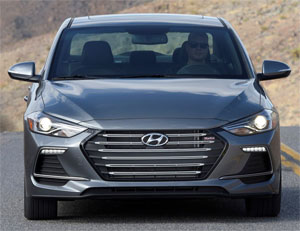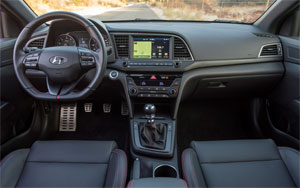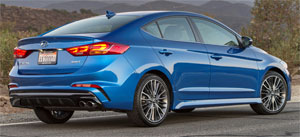2017 Hyundai Elantra Sport
Call us skeptics all you want, but whenever a carmaker tacks the word “sport” onto an existing model, we instantly look for reasons to cry foul. And when it comes to Hyundai, well they haven’t really delivered too much in the way of “sporty” goods lately. Well, let’s see if that changes with a new Elantra sport.
When we last left the 2017 Hyundai Elantra, we predicted its increased refinement and competency would do wonders to help it become increasingly competitive against more established rivals from Honda and Toyota.
Well that has indeed been the case, so adding a Sport version into the mix, should only help the cause even more. Right?
And, hiring a BMW M engineering veteran to help put an all new multi-link suspension under the rear of this sedan is certainly a good way to start. The Elantra Sport’s new setup really makes it feel well-balanced and nimble; yet there’s no harshness to it, as overall ride quality remains quite good.
 Front and rear spring rates are increased, thicker stabilizer bars are in place, and standard wheels are 18s. The total result is nicely solid grip through the cones. It stayed surprisingly flat as well, with enough steering feel to bring a smile or two to our faces. So, yea!
Front and rear spring rates are increased, thicker stabilizer bars are in place, and standard wheels are 18s. The total result is nicely solid grip through the cones. It stayed surprisingly flat as well, with enough steering feel to bring a smile or two to our faces. So, yea!
Hyundai’s 1.6-liter I4 turbo deals out the power; with horsepower at 201; torque, at 195 lb-ft. And there’s even a 6-speed manual transmission standard. A 7-speed DCT is available.
With the manual, we launched the Sport to 60 in 7.0-seconds flat; two seconds quicker than our last Elantra sedan test. Engine noise is, however, fairly pronounced; making us wish the more pleasing notes coming from the exhaust were louder.
We love the manual tranny. Shifter throws might be a little long for some, but come on, this is not a high-dollar performance car; just enjoy the fact that you get to have some interaction with a car for a change.
The ¼-mile was almost two seconds quicker too, at 15.6-seconds at 92 miles-per-hour. Quite a difference; and combined with the handling attributes, we think Hyundai has done more than enough to earn the Sport moniker.
The exterior gets an upgrade as well, with a more aggressive body kit; featuring a new front fascia with a black grille and unique lighting, sill extensions down the sides, and dual chrome exhaust tips for the diffuser-style rear fascia.
 Inside, there are sport seats with more bolstering and red stitching, as well as a new flat-bottom steering wheel. The logical layout is familiar Hyundai, and there even seems to be some shared switchgear with Kia.
Inside, there are sport seats with more bolstering and red stitching, as well as a new flat-bottom steering wheel. The logical layout is familiar Hyundai, and there even seems to be some shared switchgear with Kia.
But that’s not all that’s new on the Elantra home front however, as 2018 brings a new Elantra GT hatchback.
As before, this Elantra is based on the European Hyundai i30. So it’s actually quite different than the sedan; especially inside where you’ll find a whole new dash and control layout, one that we’re quite fond of.
"This Hyundai Elantra GT represents the brand’s latest thinking about small cars, and is clearly aimed at those that might want a small utility vehicle instead. You sit rather high and the boxy hatchback rear end means plenty of cargo versatility. I like the fact the tablet-style media interface uses not only a touchscreen but there’s plenty of knobs and switches to control it. So, it’s not only modern it’s smart."
That SUV-style cargo volume measures 24.9 cubic-ft. seats up, 55.1 with rear seat backs folded. The downside, rear seat leg room that isn’t as generous as the sedan.
 Power for the Elantra GT comes from a naturally-aspirated 2.0-liter I4 with 161-horsepwer and 150 lb-ft. of torque, though a GT Sport model, with the 1.6-turbo is available as well.
Power for the Elantra GT comes from a naturally-aspirated 2.0-liter I4 with 161-horsepwer and 150 lb-ft. of torque, though a GT Sport model, with the 1.6-turbo is available as well.
Government Fuel Economy Ratings for the 2.0-liter Elantra GT automatic are 24-City, 32-Highway, and 27-Combined. For the Elantra Sport manual, they’re 22-City, 30-Highway, and 25-Combined.
Still, that’s only an average Energy Impact Score with use of 13.2-barrels of oil annually with CO2 emissions of 5.9-tons.
Elantra Sport pricing starts very sensibly, at $22,485; $4,500 over the much less entertaining base SE model. Elantra GTs begin at $20,235.
The 2017 Hyundai Elantra Sport may fall short of performance-only machines like the Focus ST or Impreza WRX, but it’s certainly a bigger step in that direction than they’ve previously made. So, it offers a quite rewarding driving experience without compromising daily family car livability. As for the 2018 Elantra GT; it offers a sporty alternative to small front-drive crossovers; making a great case for the compact hatchback.
So, as we see it, the latest Elantra, in all its forms, is indeed more competitive, and now more entertaining, than it’s ever been.
Specifications
- Engine: 1.6 liter
- Horsepower: 201
- Torque: 195 lb-ft.
- 0-60 mph: 7.0 seconds
- 1/4 mile: 15.6 seconds @ 92 mph
- EPA: 22 mpg city / 30 mpg highway
- Energy Impact: 13.2 barrels of oil/yr
- CO2 Emissions: 5.9 tons/yr
2025 Volkswagen ID. Buzz
Volkswagen Brings Beetlemania Level Of Excitement To Minivan Segment
The duty of upholding Volkswagen’s heritage has most recently been delegated to small legacy car names like Golf and Jetta. But hold on! A much larger, totally modern take on VW’s classic microbus has just buzzed over the horizon— the all-electric ID. Buzz. It’s been at the top of our minds since we first saw the concept back in 2017. Well, it’s finally here, so let’s get our groove into drive!
This 2025 Volkswagen ID. Buzz has indeed created the most buzz around Volkswagen since the Beetle’s return to the U.S. in the late 1990s. We couldn’t drive it anywhere without drawing a crowd. No wonder, just about everyone has a VW Microbus story to tell, and seeing this reimagined version rolling down the street brings back all those memories.
VW really pulled it off as far as we’re concerned, as it looks great without appearing over the top. All the cues are here: Big VW logo front and center, lots of greenhouse including A-pillar windows and mini sliders for the second-row passengers, D-pillar air vents, and two-tone wheels. And while its appearance may be pure retro, its drivetrain is far from it, as the ID. Buzz is all-electric, and unlike the new Beetle, the Buzz does retain the original Microbus’ rear-drive architecture.
Powering those rear wheels is a 210-kW motor drawing juice from a 91-kWh battery for a range of 234 miles; 200-kW max charging will get you to 80% in about 26 minutes. Buyers can add another small 80-kW motor up front for 4motion all-wheel-drive and an increase of total output from 282 to 335 horsepower with a combined 512 lb-ft of torque. It uses the same battery, but range estimates drop just slightly to 231 miles. But while those numbers are modest, we also found them to be quite conservative, as we observed as many as 287 miles available in our all-wheel-drive tester’s gauge display and were on pace for 273 miles in our driving loop.
One throwback theme that may be a turnoff to some is that it’s quite a step up into the Buzz’s front seats, but there’s certainly a commanding view of the road once you climb in. Second row seating can be either a three-place bench or a pair of captain’s chairs, so there’s generous room for seven or six passengers. The captain’s chairs in our Pro S Plus offer good support and very easy access to the third row.
Lots of flexibility too with the option to simply fold the seats or remove them altogether.
With the sliding side doors and a wide opening rear hatch, there’s plenty of access for loading big sport utility amounts of cargo. Lots of flexibility too with the option to simply fold the seats or remove them altogether, and the ability to create a full-length flat floor with a rear cargo shelf that covers some handy removable storage bins. There’s 18.6 cubic-feet of space behind the third row, 75.5 behind the second, and a max of 145.5. That’s more than a Chevrolet Tahoe. For smaller items, there are lots of cubbies throughout the cabin, along with a standard Buzz Box that can be moved to multiple locations.
With a design that prioritizes retro form and modern function over aero efficiency, the 4motion equipped ID. Buzz earns a Fair efficiency rating, using 42-kWh of electricity per 100 miles, and we weren’t sure what to expect at our Mason Dixon test track.
What we found was great torque off the line and drama free launches to 60 in just 5.3 seconds. It was very stable at speed and power delivery stayed steady most of the way down the track until we reached about 90 mph, when it began to taper off just before we finished the quarter-mile in 14.0 seconds flat at 97 mph.
With 1,200-lbs. of battery weight nestled in its 127.5-inch wheelbase, the Buzz felt planted to the pavement through our handling course. There was quite a bit of body roll to deal with, but surprisingly little understeer. In panic braking runs, pedal response was inconsistent, feeling soft at times, pushing back hard at others; but through it all, results were quite good, stopping from 60 in an average of just 108 feet.
Three interior themes are available, this Dune is the brightest, featuring coastal inspired wood optic dash décor, “gray and clay” leatherette surfaces, and a high-mounted central 12.9-inch touchscreen. Pricing starts with a rear-wheel-drive Pro S at $61,545; this Pro S Plus begins at $65,045, add another $4,500 for 4motion, which brings a few extra features along with all-wheel drive.
Retro design with old-school VW charm, modern EV drivetrain, big SUV capacity merged with minivan flexibility; it all comes together in this 2025 Volkswagen ID. Buzz. It’s easily one of the coolest rides of the year and one that will likely keep Volkswagen dealers buzzing for years to come, and that’s something no other people and things mover can say.
Specifications
As Tested
- Motor Setup: Dual-Motor AWD
- Battery Size: 91-kWh
- Horsepower: 335
- Torque: 512 lb-ft
- EPA Range: 231 miles
- 0-60 mph: 5.3 seconds
- 1/4 Mile: 14.0 seconds at 97 mph
- Braking, 60-0: 108 feet
- MW Test Loop: ~ 273 miles













































